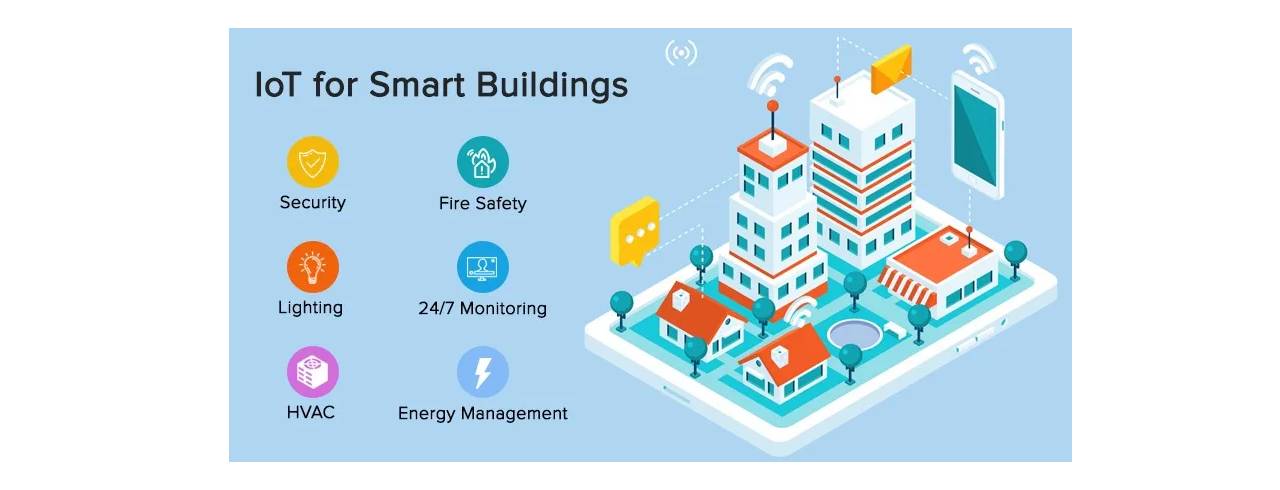Owners, facility managers, & building tenants are all seeing their roles in commercial buildings evolve due to technological advancements. Today's smart buildings IoT & smart building analytics provide previously unattainable insight about building equipment, maintenance, quality of air, and energy use, including system integration in buildings of all types.
On the other hand, these technologies have merely touched the surface of what they would accomplish. Innovating the smart home The Internet of Things (IoT) is opening up new avenues for simplifying and optimizing processes.
A smart building uses real-time variables to automate building functions in order to meet certain objectives.

Using sensors, actuators, & microchips, a smart building IoT may collect and manage data based on a company's activities and services." As a result of these infrastructural improvements, owners, operators & facility managers are able to improve asset performance and reliability while reducing energy consumption and optimizing space utilization.
Technology is what provides "intelligence" to constructed buildings. Intelligence, on the other hand, is not a property of a single part of the system. IoT devices, machine learning software, and automated management systems play a role in this technological ecosystem (BMSs).
Software and hardware that is well-designed can be used to construct smart buildings. In order to reach your goals, every component of these systems must be carefully selected.
An IoT Object -
The Internet of Things (IoT) relies on a wide range of sensor devices for smart power buildings. These devices can function with the existing electrical network of retrofit structures, but they are more commonly used with wireless access points because they are easier to install.
Common IoT gadgets include:
● Temperature\sHumidity
● Motion\sOccupancy
● Contact
● Quality of indoor air
● Gas\sSmoke\sPressure\sProximity
● quality of water
● Monitoring of electrical current
Many IoT devices use open protocols. They can connect devices and systems, as well as analytics platforms as well as other building software.
● Connectivity
Despite their importance, wireless devices will not completely replace the connected legacy systems existing in many buildings when it comes to smart buildings. Wireless gadgets supplement a smart building's cabling backbone. As a result, renovating older buildings is often necessary, which necessitates breaking down walls or installing ports. As a result of the increased costs, new methods have been created.
Smart buildings using IoT rely on built-in wireless devices, whereas wired IT infrastructure follows common paths and consolidation points with the building's electricity system. Using Power over Ethernet (PoE) technology, Internet cabling may also deliver electricity.
Architects and designers of smart buildings benefit greatly from the increased flexibility this provides, despite the fact that fixed cabling paths are still used. Newer advancements like Li-Fi, which could replace older communications technology, are being researched to further build connections in built environments.
In smart buildings, Wi-Fi reliability is a major challenge. Connectivity is required for IoT devices to exchange data. Controlling smart buildings even when the internet is unavailable is possible through various methods.
● The Cloud
Data can now be safely harnessed through the use of cloud computing. Using the cloud saves you money upfront and gives you greater adaptability as your business's needs evolve.
Regulatory requirements necessitate on-site data storage in some structures.
While on-premises servers may be less secure, the finest cloud companies employ cutting-edge cybersecurity measures and do not need virtual private networks (VPNs). For redundancy, a cloud service provider can also back up vital data on various servers located across several locations.
The best-in-breed solutions allow users to combine the most software solutions and gadgets from many designers and manufacturers, notwithstanding the ongoing debate about which security tactics to utilize.
The power of data comes from the use of analytics tools. Advanced analytics platforms continuously mine data to provide comprehensive visibility to building performance & optimize systems. As a result, people will be able to live in more pleasant, healthier, and cost-effective surroundings.
Analytical software's qualities include:
● Any connected device can access data in a mobile-first dashboard.
● The necessity for user intervention and the likelihood of human error are reduced thanks to advanced automation options based on bespoke rules.
● Over time, the ability of machines to learn improves automation.
Advanced fault detection & diagnostics identify the root causes and prescribe the best course of action as soon as anomalies are detected.
Prioritized notifications limit the number of unnecessary alarms.
Predictive analytics can help you foresee potential problems before they happen, giving you the information to develop proactive plans. For all stakeholders, customizable statistics with user-friendly graphics are essential. With analytics, you take command of your smart building on a whole new level & gain direct access to its brains.
The Nordic nRF52840/nRF52833 SoC by BLE module, with an optimized & comprehensive radio design of PCB antenna, is used in an ultra-low-power wireless BLE 5.0/5.1 Module. In addition to USB access, up to 8 dBm transmission power, 802.15.4 (Thread/Zigbee) implementations, Bluetooth 5 Long Range Feature, and sophisticated security abilities, MS88SF3 takes out all nRF52840/nRF52833 equipment functions and functionality. Get more ble modules there.
IoT devices—sensors, software, with online connectivity—monitor various building parameters, analyze the data, and create insights that can be utilized to manage the environment & operations of a building, such as identifying usage patterns and trends.
With the internet of things buildings, buildings are already becoming smarter because this technology can link hundreds of sensors and provide real-time analysis of data that will create buildings that are more efficient & user-friendly in the near future.
Electronically managed, internet-connected devices can be used to control household appliances. Complex lighting and heating systems can be pre-programmed, a central hub, and a mobile app for controlling them from anywhere in the world.
Sensors, protocols, actuators, cloud services, and layers all fall under the umbrella of IoT building management. In addition to devices and sensors, the IoT architecture layers are characterized by protocols & gateways to check the integrity of a system.